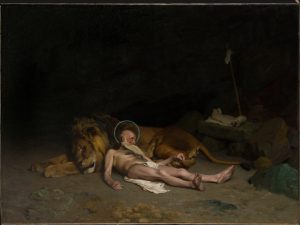Words on the Word
St Jerome
This homily was given in German as part of a retreat for priests at Maria Rosenberg. You can find an English version by scrolling down.
Das biographische Profil des Hieronymus ist uns wohlbekannt. Wir sind vertraut mit seinem durch Fasten gemarterten Körper, seinem roten Kardinalshut, seinem Löwen und seiner scharfen Zunge. Vor allem ist er aber der große Exeget, der uns sagt: wer die Schrift nicht ordentlich kennt, kennt Christus nicht.
Es ist gut, gerade im Moment daran erinnert zu werden. Unsere Zeit tendiert dazu, den Glauben subjektiv und sentimental auszulegen. Oft wird von Christus gesprochen als ob man ihn frei aus eigenem Empfinden hervorzaubern könnte, wie ein Kaninchen aus einem alten Zylinderhut.
Aber nein: der Herr ist derselbe heute, gestern und für immer: hodie, heri, semper.
Hieronymus war durchdrungen von der Schrift. Er hat sie nicht nur kommentiert, er hat sie übersetzt, einige Bücher sogar zweimal, zuerst aus dem Griechischen, dann aus dem Hebräischen. Durch seine Vulgata hat er das religiöse Empfinden des Westens geprägt. Seine Übersetzung ist ein literarisches Meisterwerk. Sie bleibt auch bis heute ein Monument der Exegese.
Hieronymus konnte diese Übersetzung schaffen nicht nur weil er die alten Sprachen meisterte, nicht nur weil er die Bibel von innen kannte; er hatte auch eine tiefe Kenntnis der gegenwärtigen, profanen Literatur. So konnte er frei auf der ganzen Klaviatur des Ausdrucks spielen — mit wunderbaren Improvisationen.
Sein Beispiel lädt uns ein zur Nachahmung.
Denn das Wort, das im Anfang war, muss jetzt in seiner vollen, ewigen Schönheit erklingen.
Es braucht dafür eine adequate Sprache, adequate Sprachröhre.
***
The biographical profile of St Jerome is well known to us. We are familiar with his gaunt body, formed by fasting, with his galero, his lion, his sharp tongue. Above all, he was the incomparable exegete who tells us: ignorance of the Scriptures is ignorance of Christ.
It is good to be reminded of this now. Our time is apt to subjectivise and sentimentalise faith. Often enough we hear Christ spoken of as if anyone were free to conjure an image of him forth from his or her own imagination, like a rabbit from an old top hat.
But no, the Lord is the same today, yesterday, and forever: hodie, heri, semper.
Jerome was soaked in Scripture. Not only did he write commentaries on it; he translated it, some books twice, first from Greek, then from Hebrew. Through his Vulgate he formed Western consciousness.
His translation is a literary masterpiece. In addition, it remains a precious work of exegesis. Jerome could produce it not just because he mastered the ancient languages and knew the Bible from within; he also had profound knowledge of contemporary profane literature.
So he could pull out and combine all the stops of the register of expression, with wonderful improvisations. His example invites us to do likewise.
The Word that was in the beginning must resound in its full, eternal beauty now.
For that purpose it requires adequate language, and adequate spokesmen.

St Jerome is one of the most painted saints in the calendar. His trajectory and character gave artists many motifs to play with. I like this canvas by Jean-Léon Gérôme from 1874, now in the Städel Museum. Even an austere ascetic must rest now and again. Jerome’s lion was more than an exotic prop, it could serve as a pillow. The saint’s dirty feet show him forth as a poor man and an itinerant. On an improvised desk made of desert stones lies work in progress.
